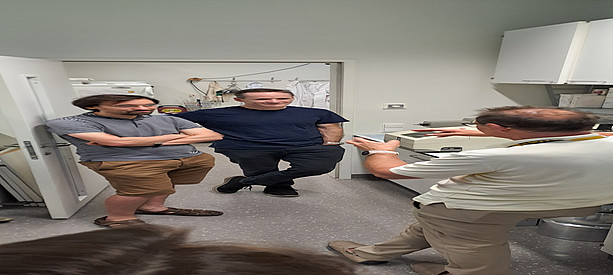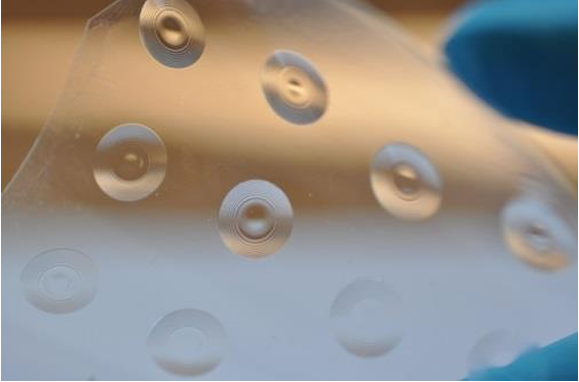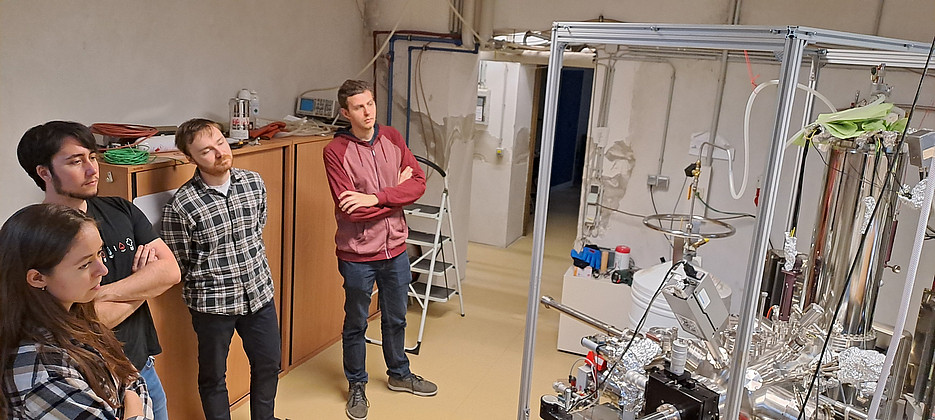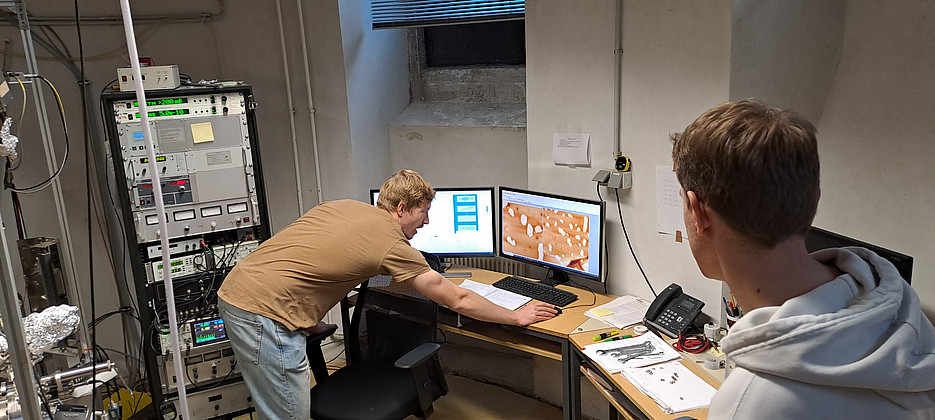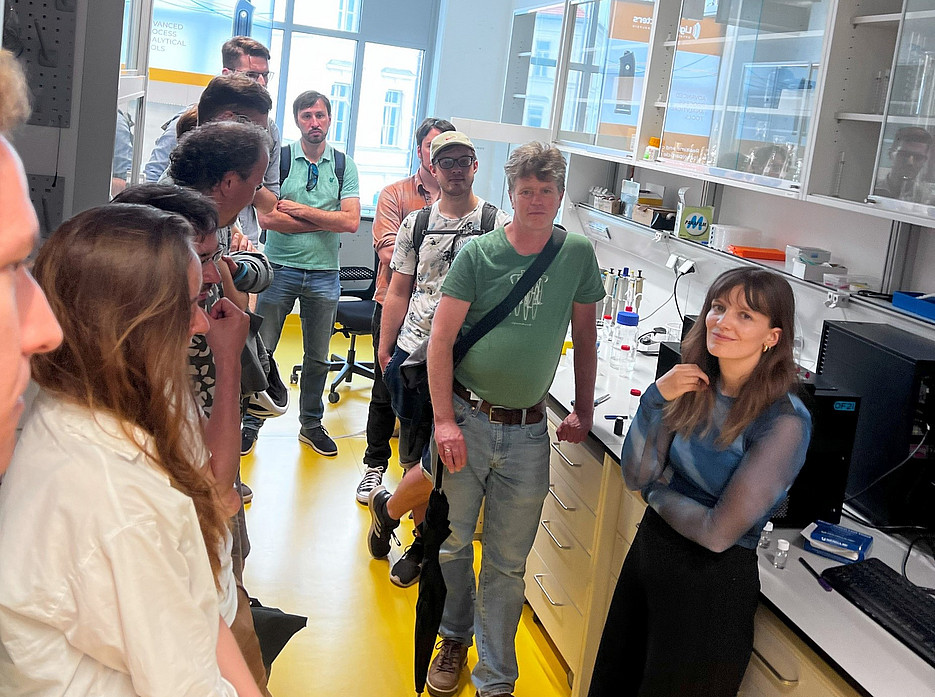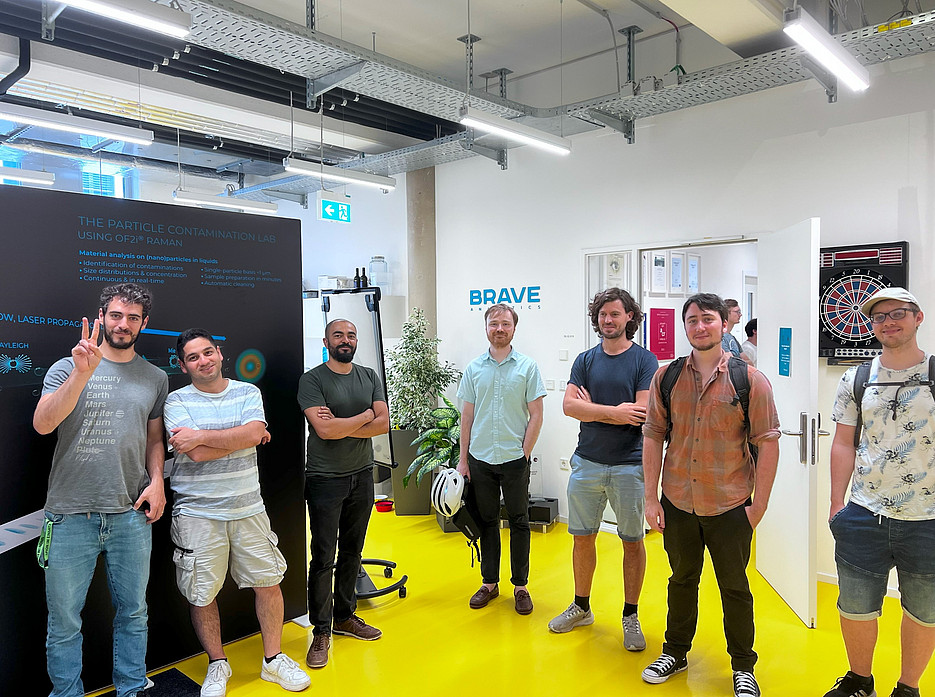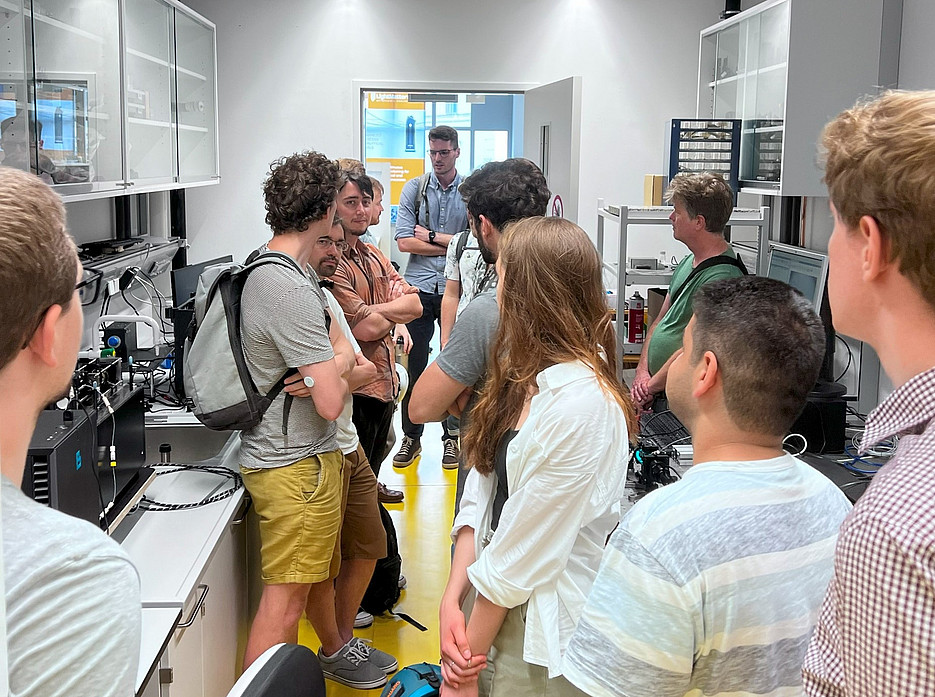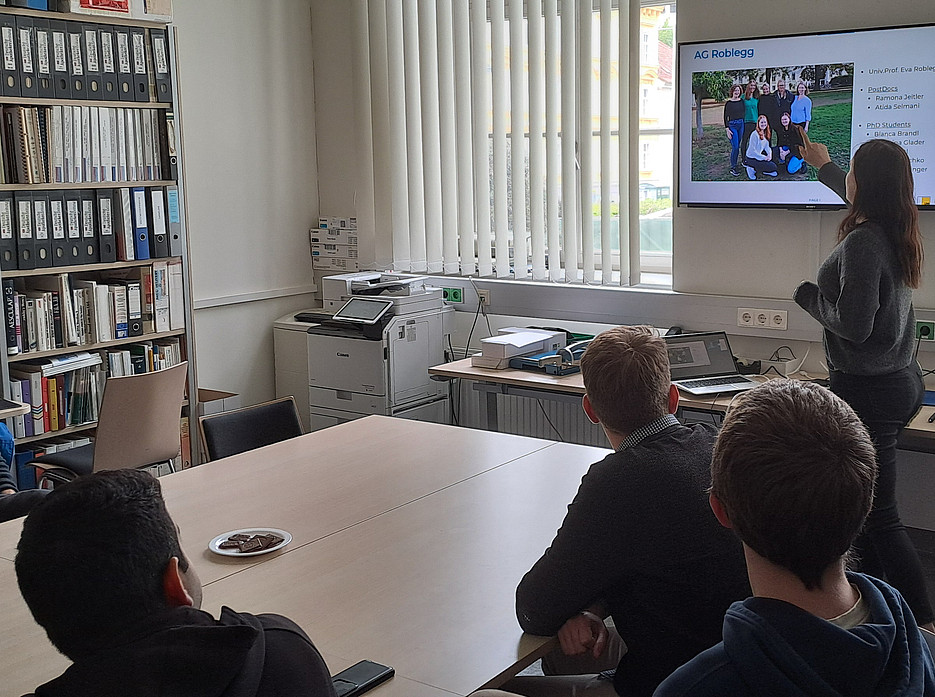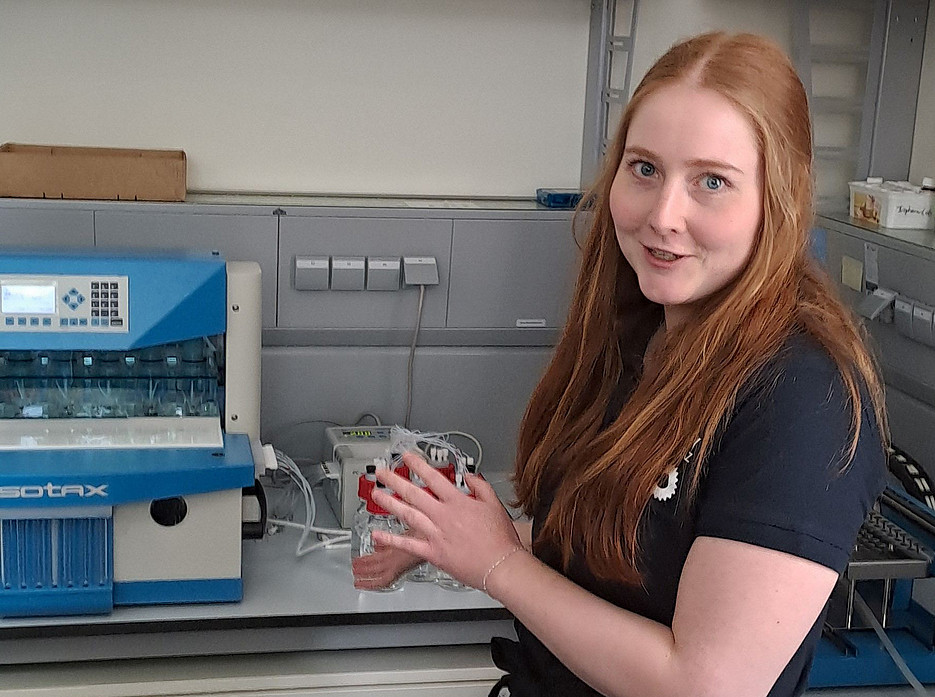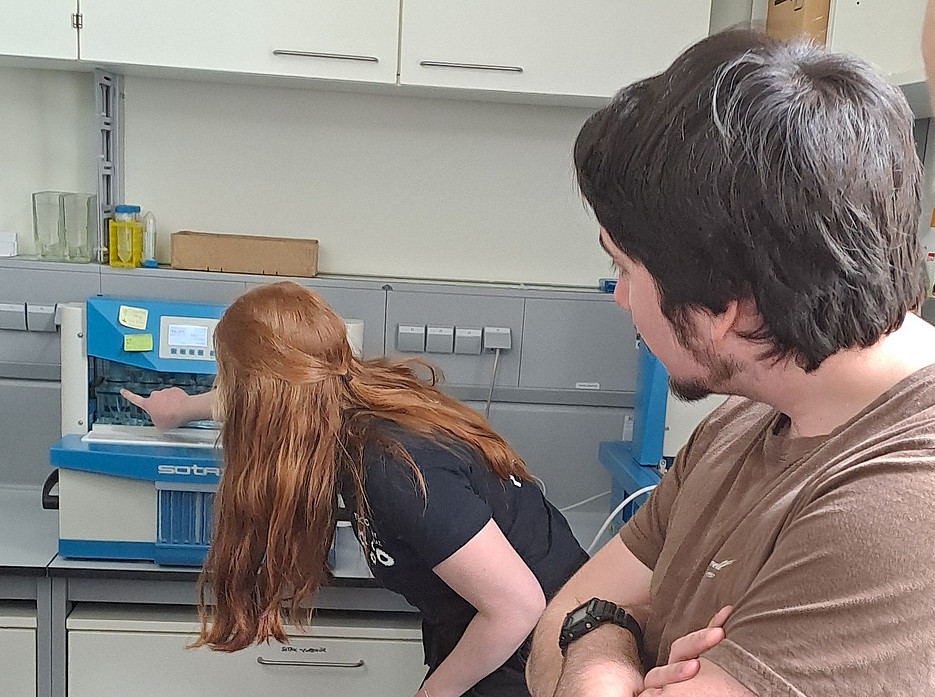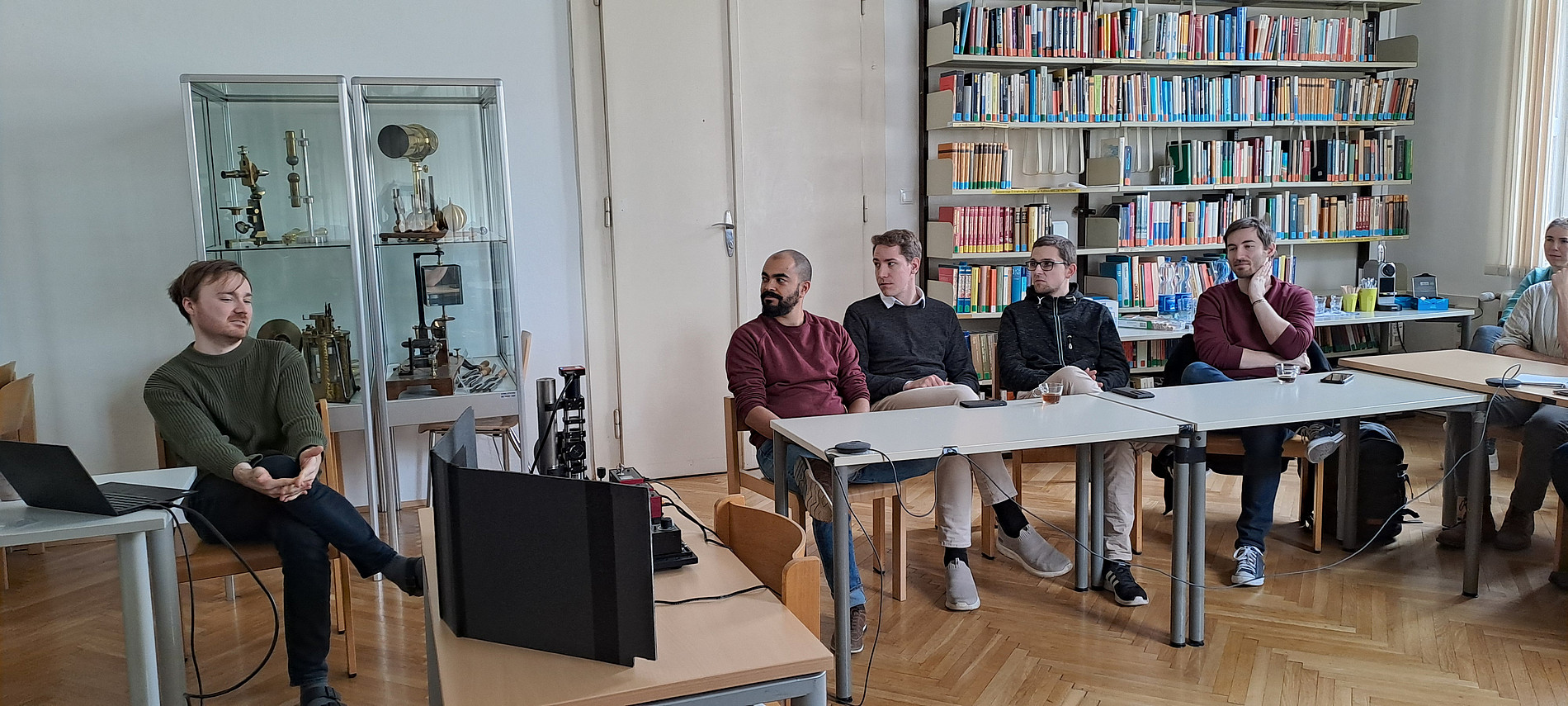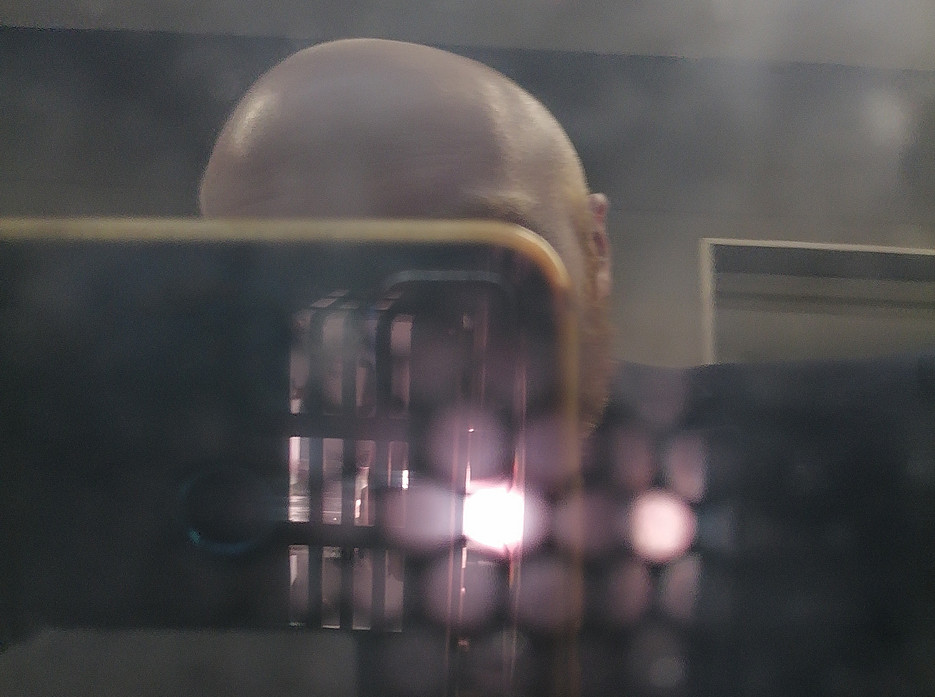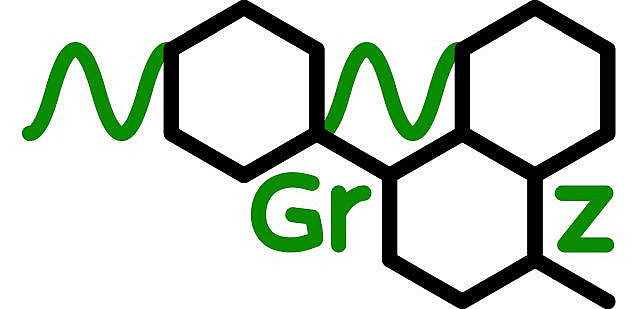
Unsere Veranstaltungen bieten eine Plattform für den Austausch von Ideen und die Vernetzung von Forschern aus verschiedenen Disziplinen, um Innovationen und Anwendungen sowie neueste Entwicklungen und Forschungsergebnisse im Bereich der Nanowissenschaften und Nanotechnologie voranzutreiben.
Monthly Meeting June 2025
On June 26, the NanoGraz meeting was held at the Institute of Pharmaceutical Sciences, Department of Pharmaceutical Technology & Biopharmacy. The research group of Professor Andreas Zimmer presented their ongoing work, with PhD student Natasa Holler and Postdoc Dr. Ivana Ruseska sharing insights on nanocarriers for targeted drug delivery and mRNA delivery systems. Participants also received a brief introduction to Dynamic Light Scattering (DLS) and Laser Diffraction (LD)—two commonly used techniques for particle size analysis—followed by a lab tour demonstrating their practical use. During the tour, attendees had the opportunity to observe fluorescence-labeled cells themselves using a fluorescence microscope.
Seminar "Physical and Theoretical Chemistry”
Quantum chemistry and machine learning for protein-ligand interactions
Jan Řezáč
Institute of Organic Chemistry and Biochemistry of the Czech Academy of Sciences, Prague, Czech Republic
Can the atomistic machine learning (ML) potentials replace traditional computational chemistry methods? I will focus in particular on non-covalent interactions in biomolecular systems, such as protein-ligand complexes, where accurate but efficient calculations are crucial for practical use in computer-aided drug design. Here, biologically relevant models often consist of hundreds or thousands of atoms, making conventional ab initio or DFT methods prohibitively expensive, and ML potentials are often proposed as a shortcut to DFT-quality results computed in a fraction of the time. However, current ML potentials are trained on small molecules, and there is evidence that they struggle to scale to larger systems. A brute-force approach of expanding the training set is not a viable option - computing additional reference data for many (~ 106) large (102 to 103 atoms) systems with accurate DFT is simply not feasible.
It becomes clear that we need to reintroduce some physics into fully empirical ML. Our approach is to use as much physics as we can afford in systems of this size - starting with semiempirical quantum chemistry, with which we have long experience and which we already successfully applied in drug design. Using ML as a correction to the semiempirical PM6 method fixes its major weaknesses, which were impossible to fix in any other way. I will present the method and compare it to other approaches using both realistic biomolecular models and benchmark data, including novel datasets covering important but previously neglected classes of non-covalent interactions.
Friday, May 23rd 2025, 2.00 pm
Lecture hall HS 10.01, Heinrichstraße 28, ground floor
Monthly Meeting May 2025
Am 22. Mai hielt Felix Lichtenegger einen Vortrag über Visible Light Positioning (VLP), eine vielversprechende Technologie mit einer Reihe von Nischenanwendungen im Bereich der Innenraum-Positionierung. Da viele dieser Anwendungsfälle eine Genauigkeit im Zentimeterbereich erfordern, sind GPS-Systeme dafür ungeeignet. Unter den verschiedenen Alternativen zeichnet sich VLP durch seine Kosteneffizienz sowie die Doppelnutzung der LED Lampen für Raumbeleuchtung, Datenübertragung und Positionsbestimmung aus.
Der erste Teil des Vortrags führte in die grundlegenden Prinzipien und die Motivation hinter VLP ein. Der zweite Teil konzentrierte sich auf spezielle flache optische Komponenten, die für kompakte Weitwinkeloptiken im VLP-Bereich eingesetzt werden können (wearable sensors). In diesem Zusammenhang wurde das Konzept von freiform mikro-optischen Elementen (free-form micro-optical elements) vorgestellt und gezeigt, wie geometrische Optik zum Design maßgeschneiderter Linsengeometrien eingesetzt wird, die anschließend kosteneffizient mittels nanoimprint lithography hergestellt werden können.
Anschließend wurde das Konzept der Metalinsen vorgestellt, bei dem die geometrische Optik durch einen wellenoptischen Ansatz ersetzt wird. Zunächst wurde das grundlegende Funktionsprinzip einfacher Metalinsen erläutert, gefolgt von der Vorstellung eines speziellen Metalinsen-Designs mit Weitwinkeleigenschaften, die mit klassischen Linsen nicht erreichbar sind. Der Vortrag griff sowohl die geometrische als auch die wellenoptische Sichtweise auf und bot einen kompakten Überblick darüber, wie beide Ansätze im modernen optischen Design Anwendung finden.
Monthly Meeting April 2025

Das Treffen der NanoGraz Doctoral Academy am 24. April 2025, organisiert von Christoph Stockinger aus der Forschungsgruppe von Prof. Peter Banzer, bot Einblicke in die aktuelle Forschung der Gruppe im Bereich photonischer integrierter Schaltungen, insbesondere in deren Anwendung als optische Detektoren.
In einem kurzen Vortrag wurden aktuelle Entwicklungen im Design und in der Umsetzung integrierter photonischer Plattformen für die fortschrittliche Lichtdetektion und -manipulation vorgestellt.
Im Anschluss an den Vortrag hatten die Teilnehmenden die Möglichkeit, die Labore der Forschungsgruppe zu besichtigen. Dabei konnten sie die experimentellen Aufbauten und photonischen Chips aus nächster Nähe kennenlernen und sich über laufende Forschungsprojekte austauschen.
Seminar "Physical and Theoretical Chemistry”
Precise control of single-molecule photoreactions by plasmonic STM tips
Akitoshi Shiotari
Fritz-Haber-Institut Berlin
Localized surface plasmons provide effective molecule-light interactions, which is highly motivating for the realization of advanced molecule-based optoelectronic devices. Although visible-laser illumination of a scanning tunneling microscopy (STM) junction between plasmonic metal electrodes induces strong electric fields confined in the nanometer scale [1], innovative precision in plasmon control is still required to induce photoreactions at the single or submolecular level.
In this talk, I will present two examples of plasmon-induced chemical reactions studied by laser-coupled low-temperature STM: photodissociation of the hydrogen-bonded network of an aromatic carboxylic acid on Ag(111) [2] and photoswitching of perylene-anhydride derivatives on Si(111)-7x7 [3]. The tuning of the plasmon resonance and the sub-Angstrom-scale positioning of the tips over the target molecules/moieties allow the control of the photoreaction rates and the understanding of the reaction mechanisms. In particular, the submolecular-scale reaction control was achieved on Si(111) [3], suggesting that molecule-semiconductor interfaces can serve as an excellent platform for single-molecule photochemistry and pico-optoelectronics.
Reference:
[1] H. Böckmann, S.r Gawinkowski, J. Waluk, M. B. Raschke, M. Wolf, and T. Kumagai, Nano Lett. 18, 152 (2018).
[2] Y. Park, A. Hammud, M. Wolf, and A. Shiotari, in preparation.
[3] Y. Park, I. Hamada, A. Hammud, T. Kumagai, M. Wolf, and A. Shiotari, Nat. Commun. 15, 6709 (2024).
Friday, 4th April 2025, 2.00 pm
Lecture hall HS 10.01, Heinrichstraße 28, ground floor
Monthly Meeting March 2025
The Doctoral Academy NanoGraz's March 27th, 2025 meeting, organized by Natalia Goncharova from the quantum chemistry group of Prof. A. D. Boese, offered a combination of theoretical insight and practical application. Following a presentation on the group's ongoing research, attendees participated in a hands-on density functional theory workshop. They calculated a reaction barrier, gaining firsthand experience in optimizing reactants and products, conducting vibrational analysis, and simulating reaction pathways.
Seminar "Physical and Theoretical Chemistry”
Junctions and Contacts in 2D semiconductor devices
Aleksandar Matkovic
Chair of Physics, Department Physics, Mechanics and Electrical Engineering, Montanuniversitaet Leoben, Austria
As the 2D materials based electronics develop towards very large-scale integrated circuits, one of the major challenges is to obtain high quality contact to 2D semiconductors. Carrier injection barriers, metal induced gap states, and consequently Fermi level pinning at the electrode interfaces hinder the integration of 2D semiconductors. Intrinsic properties of the channel 2D material are rarely accessible as usually majority of the bias intended for the carrier transport is used to overcome the contact ¬related junctions. Further, in the case of polycrystalline films and assembled nanosheet networks also junctions between adjacent domains and nanosheets govern the macroscopic response of the devices.
This talk will focus on single crystalline MoS2, WSe2, PtSe2, and on liquid phase-exfoliated and liquid-liquid interface assembled MoS2 nanosheet networks. We will review several possible electrode choices, from organic self-assembled monolayers functionalized conventional metals, to van der Waals semi-metallic contacts. The focus will be on ways to evaluate contact related losses considering macroscopic electrical measurements, device modelling, and local probing of the electrostatic potential by in operando Kelvin Probe Force Microscopy. We will see how contact engineering can enhance the properties of 2D semiconductor devices, and also tailor carrier injection into 2D channels.
[1] Matković, A., et.al., Interfacial band engineering of MoS2/gold interfaces using pyrimidine‐containing self‐assembled monolayers: toward contact‐resistance‐free bottom‐contacts. Advanced Electronic Materials 6, 2000110, 2020.
2] Murastov, G., et.al., Multi-Layer Palladium Diselenide as a Contact Material for Two-Dimensional Tungsten Diselenide Field-Effect Transistors. Nanomaterials 14, 481, 2024.
[3] Gabbett, C., et.al., Understanding how junction resistances impact the conduction mechanism in nano-networks. Nature Communications 15, 4517, 2024.
[4] Aslam, M.A., et.al., All van der Waals Semiconducting PtSe2 Field Effect Transistors with Low Contact Resistance Graphite Electrodes. Nano Letters 24, 6529, 2024.
Friday, 28th March 2025, 2.00 pm
Lecture hall HS 10.01, Heinrichstraße 28, ground floor
Monthly Meeting February 2025

Siegfried Kaidisch präsentierte am Donnerstag, den 27. Februar 2025, im Rahmen des NanoGraz-Meetings einen Vortrag zum Thema Deep Learning.
Im theoretischen Teil wurde zunächst das Universal-Approximation-Theorem für Feedforward-Netzwerke mit nicht-polynomiellen Aktivierungsfunktionen vorgestellt. Anhand dieser Grundlage wurden verschiedene Beispiele demonstriert, die veranschaulichen, wie Daten durch ein künstliches neuronales Netz (ANN) in eine gewünschte Größe oder Klasse transformiert werden können. Weiters wurde der Aufbau solcher Netzwerke, sowie die zum Training (Supervised Learning) benötigte Konzepte erklärt.
Anschließend folgte ein praktischer Teil, in dem neuronale Netze mithilfe des Python-Pakets "PyTorch" anhand des MNIST-Datensatzes trainiert wurden. Es wurde gezeigt, wie durch den Einsatz von Supervised Learning – konkret durch die Anpassung von Gewichten und Biases mittels Backpropagation und stochastischem Gradientenabstieg – die Leistung eines Netzwerks optimiert werden kann. Ein Schwerpunkt lag dabei auf der Bedeutung von Loss- und Cost-Funktionen zur Beurteilung der Netzperformance sowie auf der Notwendigkeit, Trainingsdaten in separate Mengen (Training, Validierung und Test) aufzuteilen, um Overfitting zu vermeiden.
Der vollständige Präsentationsinhalt, inklusive des PDF-Dokuments und des Beispielcodes, ist auf GitHub verfügbar:
https://github.com/siegfriedkaidisch/DeepLearning_Intro
Monthly Meeting January 2025
Am Donnerstag, den 23. Jänner, stellte Moritz Smilde die laufenden Projekte der Gruppe Membranbiophysik von Sandro Keller am Institut für Molekulare Biowissenschaften (IMB) vor.
Das Treffen begann mit einer Präsentation der aktuellen Forschung der Gruppe, einschließlich der Synthese und Charakterisierung von amphiphilen Copolymeren, die bei der Entwicklung von Lipid-Nanodiscs verwendet werden. Diese Nanodiscs dienen als wichtige Werkzeuge für die Untersuchung von Membranproteinen, wie z.B. dem mit Brustkrebs verbundenen HER2-Protein, in ihrer natürlichen Lipidumgebung. Darüber hinaus wurde ein neuer Ansatz zur Vorhersage der Ligandenbindungskooperativität anhand von Molekulardynamik-Simulationen vorgestellt.
Im zweiten Teil des Treffens erhielten die Teilnehmer*innen eine kurze Führung durch das Labor, in der verschiedene Techniken zur Untersuchung von Nanodiscs und Membranproteinen demonstriert wurden. Dazu gehören die differenzielle Rasterkalorimetrie, die zeitaufgelöste Fluoreszenzspektroskopie und die mikrofluidische diffusionsbasierte Größenbestimmung.
Seminar "Physical and Theoretical Chemistry”
Beneath the Surface: Neutron Reflectometry in Physics, Chemistry and Biology
Maximilian Skoda
Rutherford Appleton Lab, UK
Neutron reflectometry (NR) is a powerful analytical tool that provides nanoscale insights into the structure and composition of thin films and interfaces. This presentation will introduce the fundamental principles of NR and its applications to solving key challenges in physical chemistry, soft matter, and related fields. By analysing how neutrons reflect off surfaces at varying angles, NR allows for precise measurements of layer thickness, density, roughness, and composition in complex systems.
NR can investigate a wide range of layered systems at the nanoscale. Examples to be discussed include both fundamental research and more applied topics, such as batteries, fuel cell materials, and corrosion.
When applied to the physical chemistry of the atmosphere, for instance, NR has revealed the behaviour of atmospheric aerosols, pollutant adsorption on surfaces, and the properties of thin water and ice films. For example, it has elucidated how coatings on aerosol particles influence cloud formation and climate, as well as how surface reactions affect air quality and pollutant dynamics.
In soft matter chemistry, NR is essential for studying the arrangement and interactions of polymers, surfactants, and colloidal systems at interfaces—knowledge that underpins advances in coatings, adhesives, and nanotechnology. Similarly, in biochemistry, NR provides unparalleled insights into biomembranes, protein adsorption, and lipid structures, with implications for drug delivery and biosensor development.
The non-invasive nature of NR, its exceptional sensitivity to isotopic composition, and its ability to probe interfaces at atomic resolution make it a unique and versatile technique. This presentation will showcase key studies across chemistry-related disciplines, illustrating how NR contributes to our understanding of complex interfacial phenomena and supports innovation in science and technology.
Friday, 10th January 2025, 2.00 pm
Lecture hall HS 10.01, Heinrichstraße 28, ground floor
Seminar "Physical and Theoretical Chemistry”
Nanoreactor Molecular Dynamics extended to Periodic Boundary Conditions
Jan Meisner
Heinrich Heine University Düsseldorf, Institute for Physical Chemistry
Recent developments of efficient computational methods make it possible to discover chemical reactions starting from basic principles and elucidate reaction entire reaction networks autonomously, enabling a complete investigation of chemical systems with all their elementary steps, intermediates, and side reactions which might otherwise have been overlooked. Computational discovery of chemical reactions based on ab initio molecular dynamics (MD) simulations accelerated by different external forces, so-called nanoreactor molecular dynamics (MND) was recently applied to a broad variety of fields, such as combustion chemistry, atmospheric chemistry, and catalysis.
The combination of NMD with periodic boundary conditions is shown using the example of selective catalytic reduction (SCR), a substantial process reducing toxic nitrogen oxides to nitrogen. However, SCR produces the long-lasting greenhouse gas nitrous oxide (N2O) as an undesirable by-product with an unknown formation mechanism. This study aims at investigating the N2O formation mechanism in the SCR catalyzed by copper-containing zeolites by means of NMD. The workflow of automated reaction discovery and reaction detection is presented. The chemical reaction network contains the main reaction forming N2 as well as side reactions forming N2O for which a reaction mechanism could be deducted. This reaction mechanism might explain the formation of N2O as side product in SCR and can lead to an improvement of automotive catalyst design in the future to reduce N2O emission.
Friday, 29. November 2024, 2.00 pm
Besprechungsraum, Heinrichstraße 28, 5th floor
Seminar "Physical and Theoretical Chemistry”
Battling the elements: Rethinking Strategies for Characterising Nano- and Microstructures
David Clases, Thomas Lockwood, Matthias Elinkmann, Lhiam Paton, Lukas Schlatt, Marko Simic, Christian Neuper, Christian Hill, Raquel Gonzalez de Vega
Universität Graz
Nano- and microstructures play a fundamental role in basic biology and geology but are often neglected. In the past, one reason for this was a lack of suitable methods to provide complementary perspectives on integrated and discrete structures and to establish models on parameters such as sizes, masses, composition and number concentrations. Inductively coupled plasma – mass spectrometry (ICP-MS) and its associated techniques initiated a paradigm shift for the investigation of micro- and nanostructures. In its single particle (SP) mode, it is capable to count individual particles rapidly whilst estimating critical particles features in a bottom-up fashion. In conjunction with laser ablation (LA), it provides opportunities to inquire the spatial distribution of elements in micro-scaled microstructures.
This presentation will provide a general overview of ICP-MS principles in both SP and LA-ICP-MS and consider relevant instrumental and methodical facets. New approaches for the characterisation of small and heterogenous structures are covered subsequently and a focus is directed to the analysis of low abundant particles in complex matrices. A second focus is set on the hyphenation of ICP-MS and the implementation of new instrumentation, specifically optical traps and single particle Raman spectroscopy, providing new opportunities to characterise single particles from various perspectives and to create new, more comprehensive bottom-up models.
Friday, 22. November 2024, 2.00 pm
!Besprechungsraum, Heinrichstraße 28, 5th floor!
Seminar "Physical and Theoretical Chemistry”
New Strategies for Quantum Control of Nuclear Spins in Molecules
Johannes K. Krondorfer, Matthias Diez and Andreas W. Hauser
TU Graz
Two recently proposed strategies for the manipulation of nuclear spins are presented and evaluated on a theoretical level via a combination of quantum simulation and electronic structure theory.1,2,3 Both suggestions attempt to overcome the problem of addressing specific, single nuclear spins, a problem intrinsic to any method involving magnetic fields.
The first method identifies the vibrational excitation of pseudorotational motions in suitable, highly symmetric molecules as a possible way to generate localized magnetic fields. With the help of these local magnetic fields, even spin states of identical atoms within the same molecule might become individually addressable. The second method exploits the nuclear electric quadrupole moment of non-spherical nuclei to access nuclear spin states through time-dependent electric fields.
Both methods have in common, that they aim for a link between individual nuclear spin manipulation and well established technologies such as microelectronics and quantum optics. On the long run, by introducing pulsed lasers in the optical or IR regime as a tool for spin control, the long coherence times of the nuclear spin degrees of freedom might become accessible via known and proven technology standards.
References
Wilhelmer, R.; Diez, M.; Krondorfer, J. K.; Hauser, A. W. Molecular Pseudorotation in Phthalocyanines as a Tool for Magnetic Field Control at the Nanoscale. J. Am. Chem. Soc. 2024, 146 (21), 14620–14632. https://doi.org/10.1021/jacs.4c01915.
Krondorfer, J. K.; Diez, M.; Hauser, A. W. Optical Nuclear Electric Resonance in LiNa: Selective Addressing of Nuclear Spins through Pulsed Lasers. Phys. Scr. 2024, No. 99, 075307. https://doi.org/10.1088/1402-4896/ad52fe.
Krondorfer, J. K.; Hauser, A. W. Nuclear Electric Resonance for Spatially Resolved Spin Control via Pulsed Optical Excitation in the UV-Visible Spectrum. Phys. Rev. A 2023, 108, 053110. https://doi.org/10.1103/physreva.108.053110.
Friday, 15. November 2024, 2.00 pm
Lecture hall HS 10.01, Heinrichstraße 28, ground floor
Monthly Meeting Oktober 2024
Am 24. Oktober durften Max Niederreiter und Max Lasshofer, beide Mitglieder der Oberflächenphysik Forschungsgruppe unter Prof. Martin Sterrer, ihrer Kollegen des NanoGraz Konsortiums zum monatlichen Meeting willkommen heißen. Nach einer kurzen Einführung zu den Grundlagen der Oberflächenphysik und ihrer Bedeutung für Anwendungen von Katalyse bis Halbleitertechnik, folgte eine Führung durch die hochmodernen Labore der Sterrer Gruppe. Dort wurden die vielfältigen experimentellen Methoden präsentiert, die der Surface Science Gruppe zur Verfügung stehen, von der Rastertunnelmikroskopie (STM) und Röntgen-photoemissions-spektroskopie (XPS) zur Infrarot-reflektion-absorptions-spektroskopie (IRRAS). Die Kombination dieser Techniken erlaubt es die geometrischen, elektronischen und Schwingungseigenschaften von Materialien auf der atomaren Skala zu untersuchen, und ist essentiell für das grundlegende Verständnis von Nanomaterialien.
Monthly Meeting June 2024
The NANO GRAZ group convened at BRAVE Analytics, a startup located on the Medical University Graz campus, to explore innovative nanoparticle characterization technologies. The focal point of the meeting was the demonstration of OF2i® (Opto Fluidic Force Induction) [1], a technology developed by BRAVE Analytics that offers real-time, online particle size distribution (PSD) analysis in liquid samples. This method excels at managing highly polydisperse samples and is ideal for monitoring nanoparticle-based product manufacturing processes in real time [2].
In addition to OF2i®, BRAVE Analytics is advancing a RAMAN module [3] designed to extract composition-related information from samples. This development promises to enhance the analytical capabilities of the OF2i® technology further.
Separately, Raphael Hauer, a PhD student under Prof. Dr. Ulrich Hohenester, is working on a Large Particle Count (LPC) module. This module specifically targets the large particle tail of typical PSDs, focusing on particles in the low to medium μm range, providing a critical enhancement to the current particle characterization toolkit.
The session included a comprehensive introduction to the company’s history, detailed explanations of the technologies mentioned, and was concluded with a guided tour through the laboratories. During the tour, Karin Griessmair led a hands-on demonstration, showcasing the practical application of the OF2i® technology.
[1] M. Šimić, et al., Phys. Rev. Appl., 18, 024056 (2022)
[2] M. Šimić, et al., Anal. And Bioanal. Chem., 415, 5181-5191
[3] C. Neuper, et al., ChemRxiv. 2023; doi: 10.26434/chemrxiv-2023-hwgll
Monthly Meeting April 2024
On April 25, 2024, Laura Wiltschko from the research group led by Prof. Eva Roblegg organized the monthly meeting of the Doctoral Academy NanoGraz. The meeting took place in the library of the Institute of Pharmaceutical Technology and Biopharmacy. Three concise presentations were delivered by PhD candidates, offering insights into ongoing research topics.
After introducing the group members, Laura Wiltschko provided a comprehensive overview of one major sampling method for interstitial fluid, which is utilized in her thesis, namely open flow microperfusion. Following this, Christina Glader presented a segment of her research focusing on real-time quality assurance in continuous nanoparticle manufacturing. Subsequently, Bianca Brandl gave an overview of novel biodegradable subcutaneous implants manufactured via high-resolution 3D printing. Afterwards, a brief laboratory tour was held through the laboratories of pharmaceutical technology. Bianca Brandl showed an ongoing release study of her subcutaneous implants using Sotax and Laura Wiltschko presented a dermal open flow microperfusion setup, where tissue concentrations of a topical formulation were determined in ex vivo human skin.
We hope that sharing our research insights will enrich our interdisciplinary discussions and lead to new future collaborations.
Monthly Meeting March 2024
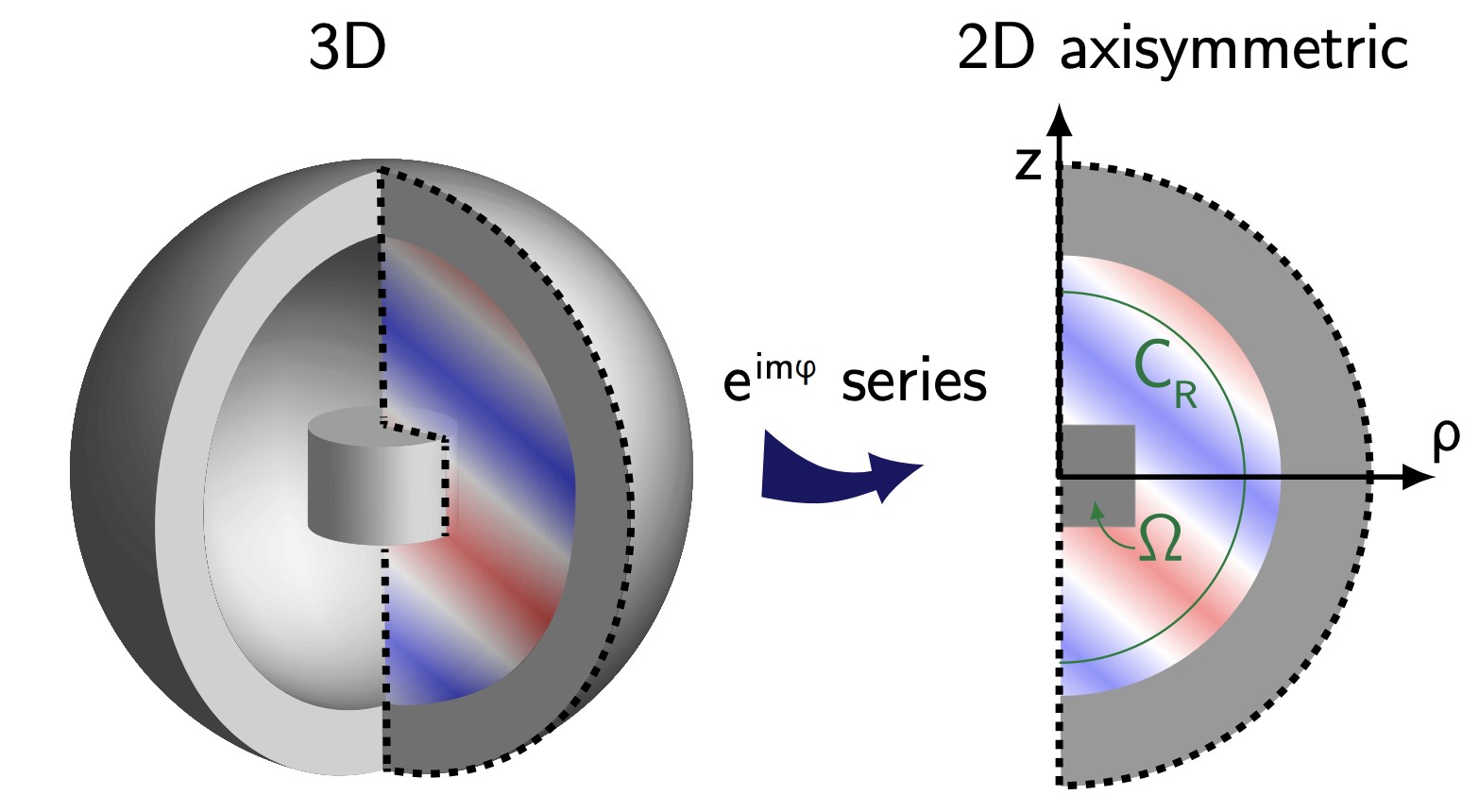
The meeting concentrated on the practical aspects of numerical modeling for systems with axial symmetry using COMSOL Multiphysics. A single particle was employed as a model to investigate methods for calculating optical forces and the scattering cross-section of a plane electromagnetic wave in such systems. Furthermore, the concept of multipole decomposition and the techniques for performing these calculations were discussed. The meeting was organized by Sergei Gladyshev, a member of Professor Thomas Weiss's research group.
Monthly Meeting February 2024
“Optical tweezers were the focus of this February’s NanoGraz meeting.
After a brief introduction to the fundamentals behind the technology, members of the NanoGraz consortium played around with the optical tweezer setup; manipulating structures from silica microbeads to living bacteria!”
Monthly Meeting January 2024
We conducted our first monthly meeting of the Doctoral Academy NanoGraz on the 25th of January at the Institute of Chemistry (Analytical Chemistry) at the KFU Graz, where our newest member Prof. David Clases gave an introduction into his group’s research, which is centered around particles with dimensions at the micro- and nanoscale (NanoMicroLab). Nanoparticles measure between 1 – 100 nm diameter in at least one dimension of space and often exhibit unique physical and chemical properties, which are not observed for their bulk analogues. These properties depend on size, composition and number concentrations and analytical techniques to determine these parameters are in high demand. However, also larger particles and structures can be found ubiquitously in the environment and in biological systems and we require new perspectives to study and understand them.
In a short presentation, Prof. Clases and his group provided an overview on the facets of inductively coupled plasma-mass spectrometry (ICP-MS) to study and to describe relevant characteristics of individual nanoparticles (Single Particle ICP-MS) as well as to map elemental distribution in microstructures (LA-ICP-MS) quantitatively. In a lab-tour, two of the most modern element mass spectrometers and a laser ablation system were prepared and demonstrated to recover, map, and quantify TiO2 nanoparticles in biological tissues.
